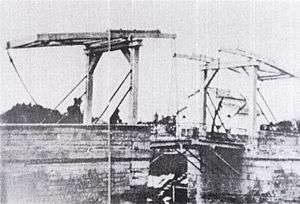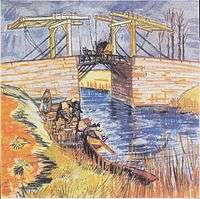Langlois Bridge
Langlois Bridge (French: Pont de Langlois) was a double-beam drawbridge in Arles, France, which was the subject of several paintings by Vincent van Gogh in 1888. Being one of eleven drawbridges built by a Dutch engineer along the channel from Arles to Port-de-Bouc, this bridge might have reminded the artist of his homeland.

History
New canals were opened up in southern France as they were needed to expand the network of canals. In the 19th century a canal was built from Arles to Bouc, located on the Mediterranean Sea. Locks and bridges were built, too, to manage water and road traffic. Just outside Arles, the first bridge was the officially titled "Pont de Réginelle"[1] but better known by the keeper's name as "Pont de Langlois".[2]
In 1930, the original drawbridge was replaced by a reinforced concrete structure which, in 1944, was blown up by the retreating Germans who destroyed all the other bridges along the canal except for the one at Fos. The Fos Bridge was dismantled in 1959 with a view to relocating it on the site of the Langlois Bridge but as a result of structural difficulties, it was finally reassembled at Montcalde Lock several kilometers away from the original site.[3][4]
A reconstructed bridge of the Langlois Bridge, named "Pont Van Gogh" (Van Gogh bridge), recognizing the works that Van Gogh made of the bridge,[5] is owned by the Arles tourist board.[6]
Depiction in art
Vincent van Gogh made several paintings, a watercolor and drawings of the Langlois bridge in a series now titled Langlois Bridge at Arles.[7]
- Gallery
- Langlois Bridge
 Langlois Bridge at Arles, watercolor. 1888. Private collection (F1480)
Langlois Bridge at Arles, watercolor. 1888. Private collection (F1480) Pont Van Gogh, replica of the Langlois Bridge
Pont Van Gogh, replica of the Langlois Bridge Pont de Langlois (red) and Pont Van Gogh (green); entrance of the canal in 1888 (blue)
Pont de Langlois (red) and Pont Van Gogh (green); entrance of the canal in 1888 (blue)
See also
- Double-beam drawbridge
- Drawbridge
- nl:Ophaalbrug, a counterweighted double-beam drawbridge used in the Netherlands
References
- Silverman, D (2000). Van Gogh and Gauguin: The Search for Sacred Art. New York: Farrar, Straus and Giroux. p. 59. ISBN 0-374-28243-9.
- "The Langlois Bridge". Permanent Collection. Van Gogh Museum. 2005–2011. Retrieved 2011-04-28" See 'Ropes' and 'Something Funny' sections of the page for more information.
- Lucien Rimeur, "Note sur le canal d'Arles à Bouc" Archived 2011-09-29 at the Wayback Machine, extraits du « Bulletin des Amis du Vieil Arles », n° 43 & 44, December 1981, March 1982. (in French) Retrieved 14 May 2011.
- "Canal d'Arles à Bouc", Projet Babel. (in French) Retrieved 14 May 2011.
- Fisher, R, ed. (2011). Fodor's France 2011. Toronto and New York: Fodor's Travel, division of Random House. p. 563. ISBN 978-1-4000-0473-7.
- Garrett, M (2006). Provence: a cultural history. Oxford and other locations: Oxford University Press. p. 208. ISBN 0-19-530957-X.
- Silverman, D (2000). Van Gogh and Gauguin: The Search for Sacred Art. New York: Farrar, Straus and Giroux. pp. 69–74. ISBN 0-374-28243-9.
| Wikimedia Commons has media related to Langlois Bridge. |